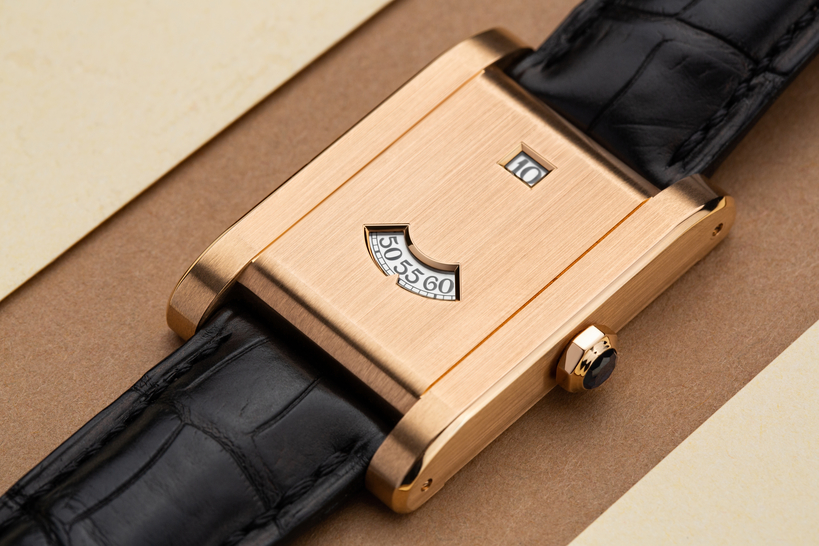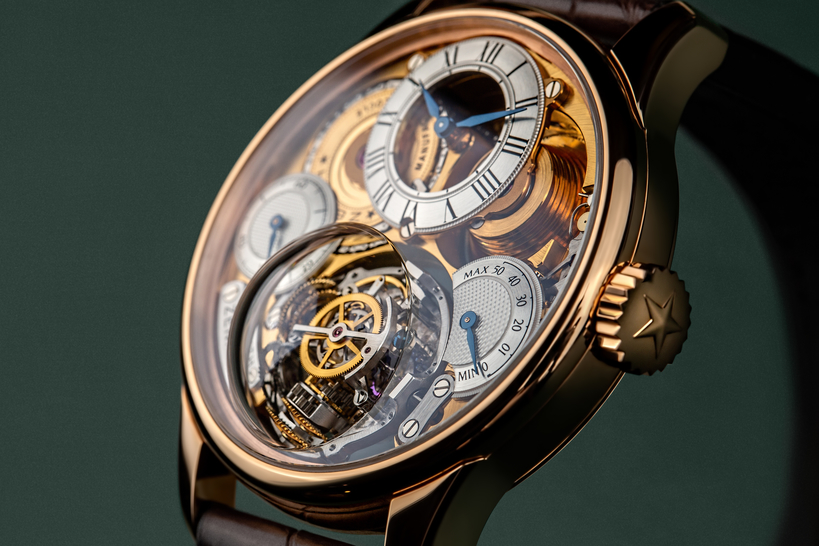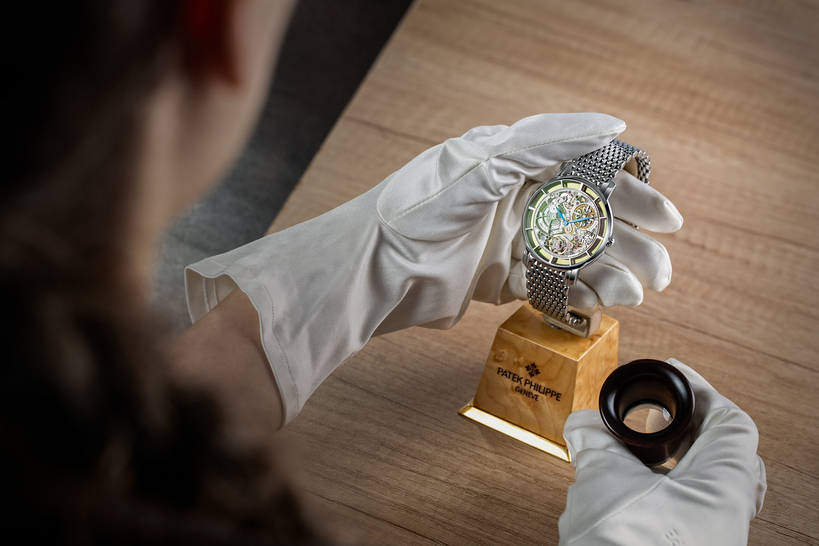From pocket watches to wristwatches.
Smith felt the need to launch wristwatches in his own name, although it wasn't easy for him to take the plunge because he had to raise the funds. This is where George Daniels helped, who enlisted Smith's help for two custom commissions.
These were wristwatches in rectangular tonneau-shaped and Arkade-inspired cases made of white gold that featured a tourbillon, co-axial escapement, and calendar. The design was suggested by Daniels, and the watches were marketed under the Daniels London brand.
This allowed Smith to put his skills to the test. The watchmaker began investing in his own brand, machines, and instruments, and established the Roger W. Smith studio In 2001. At the same time, he was still busy completing commissions for Daniels and developing his first wristwatch.
Smith was kept busy with both jobs from around 2001 to 2004. The two Daniels London wristwatch tourbillons were nicknamed "the White" (delivered to the client in March 2004) and "the Blue" (delivered to the client in April 2005).
Series 1 was Smith's first wristwatch and a special milestone in the watchmaker's career. The algorithm used to create this watch movement is a fairly common one among independent watchmakers.
Smith purchased ready-made movements and took all the functional components out — from the balance with its spring and lever escapement to the main gear train and the mainspring barrel — then he built them around a mainplate and bridges machined from scratch to shape a movement that would fit the rectangular watch case he'd come up with.
Roger Smith went on to launch another Series 1 — a watch with a round case and movement made entirely at his own workshop, where the amount of components purchased from third-party suppliers was kept to the bare minimum (these are currently the balance spring and mainspring, some of the jewels, some screws, and the strap).
In order to avoid confusing the round watch with the original Series 1, the rectangular one is now commonly referred to as the original or "old Series 1". Smith initially planned to make just twelve of the "old Series 1" pieces, but he stopped at nine. These nine pieces included three that were created in partnership with the jewelry designer Theo Fennell.
Before revisiting Series 1, Roger Smith made his first round watch and named it Series 2. He later added (and subtracted) some frills, and these clones of the round Series 2 design have been labeled Series 1 to Series 5 so far.
The initial version of Series 2 has small seconds and an "up down indicator" for the power reserve, while the revisited Series 1 is as simple as possible in terms of design, and only has small seconds.
Series 3 was given small seconds and a retrograde date, Series 4 has small seconds with a triple calendar and moon phase, while Series 5 is a version of Series 2 with an openworked dial.
In this sense, you could say that almost all watches created by Roger Smith are based on one round manually wound movement. The whole movement is made according to "the Daniels Method", as Smith himself puts it.
As for the style of the movement and its clones, they've been made in perfect compliance with the watchmaker's interpretation of the traditional English style of watchmaking, which we can also see in his pocket watches.
This mainly refers to the design of the three-quarter plates, the guilt frost finish or mirror polishing on plates and bridges, gold chatons, blued screws, and cartouches with engraved signatures.
And the Isle of Man’s Triskelion symbol, the careful global polishing on pinion flanks, as well as hand-engraved Baroque-style floral motifs in relief against a finely frosted backdrop.
Other distinct features of Smith's movements include the raised barrel bridge and balance cock over the three-quarter plate, which are often decorated with engraving. This is a leaf straight out of the English design books for pocket-watch movements. The dials on watches by Roger Smith deserve particular attention.
You can clearly see the legacy of Daniels' watches in their design, at least when it comes to the basic configuration of the hand-engraved sterling silver guilloché dials. Smith employs a traditional technique for creating dials with multiple individual parts, where the base and subdials are initially manufactured separately, and then soldered together.
That's how the watchmaker achieves very sharp borders on his chapter rings, which are typically only seen on pieces made by the finest masters of guilloché.
Roger Smith’s annual output is tiny, so almost every Roger Smith watch is commissioned like a unique piece, which is why one of the main options he offers is a hand-engraved dial.
Smith was invited to make a unique piece to promote the "GREAT Britain" campaign in 2013, which offered him more room for creativity. The Great Britain watch dial was engraved with a guilloché Union Jack and loaned to the British government, although Roger Smith has since been reunited with his watch.
As for the mechanics inside the watch, Roger Smith decided to stick to using versions of George Daniels' co-axial escapement in all his movements since the introduction of Series 2. Since then, he’s used them in all other Series 1-5 watches.
Smith used one of his early versions of Daniels' escapement in the Series 2 watches. His single wheel co-axial escapement combined the functions of the two escape wheels on one axis from Daniels' original construction, integrating them into one wheel. This version of the movement (and watch) is referred to as Mark 1.
Then when Smith began modifying the base movement in 2012, he installed a more energy-efficient version of the co-axial escapement with a lighter, reduced-inertia escape wheel.
This movement is referred to as Mark 2. It's interesting to note that the Mark 2 movement developed by Roger Smith appeared around the same time as Omega's latest version of co-axial technology, although they unfortunately don't disclose the technical details of how this version of the co-axial escapement was developed.
This similar design to Smith's reduced-inertia escape wheel first appeared in the Omega 9300 movement in 2011. It's worth noting here that Omega uses ultra-modern LIGA (or similar) technology to manufacture this component, while Roger Smith relies on traditional metal finishing techniques.
This is a manifestation of one of the watchmaker's fundamental approaches. First of all, Smith believes that the watches he creates using traditional methods are very reliable, and built to stand the test of time, especially the Mark 2 version of the movements.
Secondly, if the movements in his watches end up in a worn condition two or three centuries from now, they can be restored using the same traditional techniques, while restoring Omega's movements requires advanced technologies by today's standards, which may be abandoned, forgotten, or unnecessary in the future.
The Mark 1 version of Smith's movement has only ever been used in Series 2 watches, which have also been available in a design option with an openworked dial since 2010. Open Dial watches available with the Mark 2 generation movement are grouped in Series 5.
It’s a little confusing, but we need to keep this in mind, given Roger Smith’s chosen system to organize his watches. Despite the fact that Roger Smith himself dates the development of his latest generation of movements back to 2012, the first commercially available examples appeared in 2018 as Series 1 and Series 3 pieces.
Series 5 Open Dial and Series 2 Mark 2 were launched in 2019, then Series 4 arrived with a triple calendar and moon-phase display in 2020. Roger Smith's company was already well established and on firm footing by 2010, but he had still another joint project with George Daniels in the pipeline.
By that time, Daniels couldn't summon enough strength and energy to manufacture watches single-handedly, but still wanted to continue his wristwatch line with the co-axial escapement he'd invented. That's why he invited Smith to release one more series to mark the 35th anniversary since his invention of the co-axial escapement.
This watch is now known as the Daniels Anniversary, and like the Daniels Millennium, it would be given a movement with a quintessential English design, and this time it would be fully developed and made in the UK from start to finish, along with the entire watch. Unfortunately, Daniels didn't live to see the project completed, who died in 2011.
Nevertheless, Roger Smith made a firm decision to see these watches through to commemorate the late great watchmaker. The movement was beautifully executed in terms of style, and you can find no shortage of stylistic nods to Abraham-Louis Breguet.
Daniels wrote a book about this great historic watchmaker's timepieces called the Art of Breguet, which is regarded as the best resource detailing information about Breguet's historic pieces. A few examples would be the stepped trapezoidal bridges, the elegant refined details, blued screws, and straight-lined steel parts.
Daniels' strict standards for quality and style are fully satisfied by the case, symmetrical guilloché dial with gold chapter rings for the scales, and hands. The manually wound wristwatch was given a power reserve indicator, along with subdials for the date and small seconds, so the style of the resulting dial is reminiscent of the famous tourbillon pocket watch that Daniels created in 1994.
The first Daniels Anniversary saw the light of day in 2012, and availability of the series was limited to 35 pieces in yellow gold, and another 12 in platinum, white gold, and red gold (four in each case material). Roger Smith agrees to take custom orders for private clients from time to time, where the style and mechanics transcend his Series boundaries.
These are mainly tourbillon wristwatches which are essentially a continuation of the Blue and White tourbillons Smith made for Daniels' clients in the early 2000s. There are currently only four known examples of these watches: delivered in 2006 (No. 3), 2010 (No. 1), 2013 (No. 4), and 2015 (No. 2).
Roger Smith's latest achievement to date concerns the fate of his watches on the pre-owned watch market. Pocket Watch No. 2 remained in Roger Smith's possession until 2004, when he sold it to a collector with the aim of raising funds to develop his own brand.
In 2023, this piece resurfaced on the market, and was auctioned off by Phillips for USD 4.9 million, overtaking the George Daniels Space Traveler's I and Space Traveler's II pocket watches to clinch the title of the most expensive British-made pocket watch ever sold.
Previosly (part I)
Credits taken from: www.phillips.com, www.acollectedman.com, www.watchclub.com, www.thehourglass.com, www.rwsmithwatches.com

















